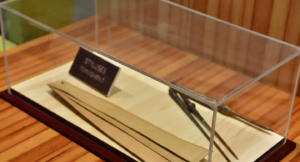
Since earlier times, recording events have been popular in the sub-continent where the people of the ancient era were engraving literature and illustrations on brick bark and palm leaves . In the first place, it was composed by the upper class who specifically concentrated on the religious dimensions, later on shifted to the lower strata when people started engaging in the urban market areas. However, the manuscripts survived no longer than that of four to five centuries due to the tropical climatic condition which forced the patrons to commission a scribe to copy the earlier remains. The engraving of glimpses of the past on palm leaves was majorly prominent in Bengal, Orissa, South India, and some countries like Nepal, Burma, Sri Lanka, Cambodia, Thailand, and Indonesia. Nevertheless, now they are constrained to a certain region within a specific section of society which is largely preserved by the libraries and museums in India in general and Kerala in particular.
The transmission of knowledge and wisdom by scholars was done orally and eventually penned down by their followers. Writing in the subcontinent started as early as the 5th century BCE for which the first reference is found in a pali Buddhist canon of the 5th century BCE. However, Kerala, the land of great scholars became the major focus of attraction for a rich tradition of preserving the teaching and studies in the form of palm leaf manuscripts. According to scholars, the oldest one belongs to the 10th century CE. Citra Ramayana, Scholars argued that its short-term durable nature is the reason for its undefined origin and support this by providing the evidence of visual representations seen in several monuments and sculptures depicting the art of composing literary work depicting the use of palm leaves.
The three palm leaves more prominently used by scribes in the early times were Borassus Flabellifer linn or palmyra palm; Corypha Umbraculifera Linn or Talipot or the earliest type of palm leaf used for compiling manuscripts; Corypha Taliera Roxb. further, there are categories for arranging and compiling the manuscripts such as churuna (roll of palm leaves manuscripts, loosen sheets scrolled in bundle having specific size with holes); Grandha (manuscripts preserved within the wooden flaps mainly the ancient scriptures); and Ozhukku (contains a record of boundaries of land fixed after survey). In Kerala, the Palmyra palm and talipot were more frequently used for horoscopes, ayurvedic documents, and religious scriptures.

The methods of preparation of manuscripts vary from region to region, most common being the drying of palm leaves in the sun after stripping out the leaflets from the leaf, cutting them into particular sizes, and later rubbing them with sesame oil. After 2-3 days, boiled with rice either in water or milk, sometimes fresh turmeric juice is also used and lastly, oil is applied again to remove the acidic impurities and closing of small holes in leaflets. The length and width i.e. 15-60cm and 3-12 cm respectively of palm leaves are processed and prepared before scribing and later stored between two wooden panels slightly larger in size, sometimes painted and decorated with ivory and also polished with insecticide oils. After the preparation of manuscripts, the scribes are commissioned to copy down the texts; a customary practice of content transfer on the new leaves.

The writing of manuscripts is a skilled activity that requires patience, practice, and training. Lekhanakaras or engravers were individual artists belonging to different castes. They used a particular kind of instrument to scratch letters on leaves i.e. the stylus or Narayam. It is an iron rod that is 8 inches long whose one end is pointed and the other is of the shape of half a leaf. The ink (masi) used is prepared by mixing powdered charcoal with gum and sugar and finally dissolved in water. The scribes wrote from the right hand and used the left hand to support the leaves. Also, the left hand helps in supporting and directing the stylus and hence controls the proper alignment and position to start the next letter. Great attention was paid to make the writing error free as corrections were difficult to make.
There are at least 70,000 palm leaf manuscripts as old as 500 years preserved at the Manuscript Library and the University of Kerala Oriental Research Institute, Thrivanthampuram. Due to their organic nature , the leaves were prone to deteriorate through physical damage or decay. Therefore, multiple preservation methods were used such as using natural herbs (margosas leaves) to make them insect resistant; camphor oil and lemongrass oil was used to keep it flexible by reducing its brittleness.
The significance behind the preservation of these manuscripts is the interest of the scholars referring to them as a source of recreating the past which is said to be inherited by ancestors, generation after generation. They were preserved as the medium of disseminating information until the coming of the printing press. Later, also worked as a source for generating income in the rural areas. The manuscripts reflected human society and expressions of specific timelines which the scholars got to know with the help of colophons or the content of manuscripts. They are a rich testimony to the cultural heritage of India including folk literature, natives, medicinal formulae, religious writings, and much more. But unfortunately, this practice is gradually declining; subdued by the emergence of extreme modernization.

